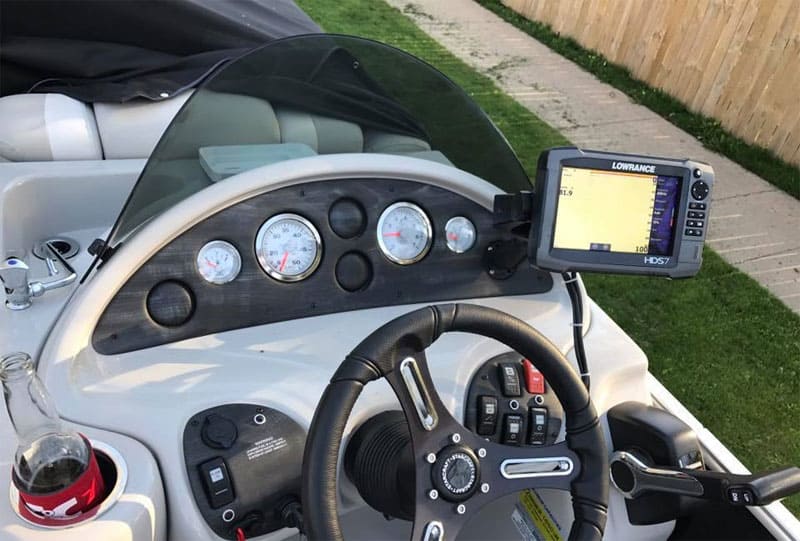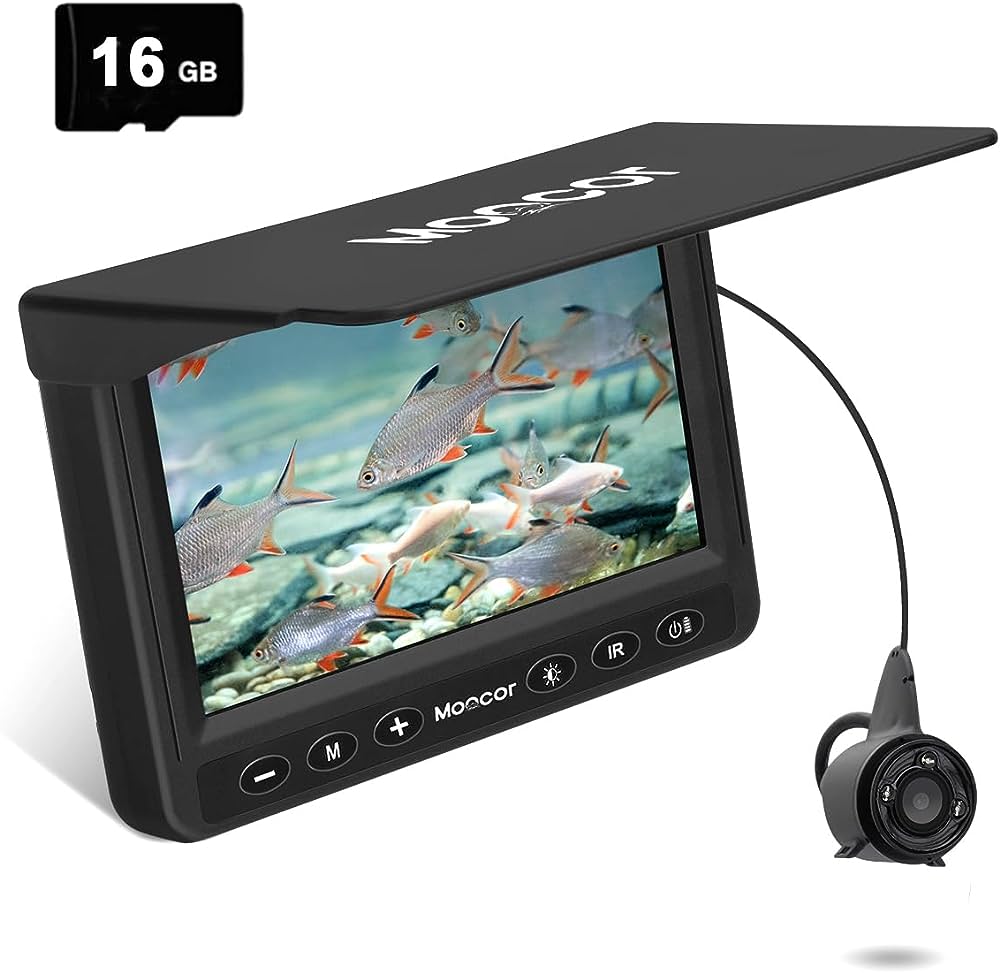The fish finder transducer on a pontoon boat should be mounted on the back, near the centerline. When installing a fish finder transducer on a pontoon boat, it is important to find the right location that will provide accurate readings and avoid interference.
One of the ideal spots is at the back of the boat, near the centerline. This placement allows the transducer to be submerged in water and provides a clear sonar signal without any obstruction. Additionally, mounting the transducer in this location ensures that it is protected from damage caused by boat trailers or underwater obstacles.
By following these guidelines, pontoon boat owners can optimize the performance of their fish finder and have a more successful fishing experience.
Understanding The Importance Of Proper Transducer Placement
Understanding the significance of proper transducer placement is crucial for accurate fish-finding results. Incorrect placement can significantly impact sonar performance and distort data interpretation. Mounting the fish finder transducer on a pontoon boat requires careful consideration. Ideally, it should be mounted on the inside of the boat’s hull to ensure maximum contact with the water.
Placing it near any objects that may cause interference should be avoided. Additionally, the transducer should be installed in a location where it remains submerged even during high-speed operation. This ensures continuous and reliable sonar readings. By adhering to these principles, anglers can optimize their fish finder’s performance and make the most of their fishing experience on a pontoon boat.
Factors To Consider Before Mounting The Transducer
Factors to consider before mounting the transducer on your pontoon boat include assessing the type and model of your fish finder, examining the design and structure of your boat, and considering the material used for the transom. The type and model of the fish finder will determine where the transducer should be positioned for optimal performance.
The design and structure of your pontoon boat will affect the placement and installation process, ensuring a secure and stable mounting. The material used for the boat’s transom should be taken into account to ensure compatibility with the transducer mounting options available.
By carefully considering these factors, you can ensure a successful and effective installation of a fish finder transducer on your pontoon boat.
Transom Mount
When mounting a fish finder transducer on a pontoon boat, one option is the transom mount. This method, which involves attaching the transducer to the boat’s transom, offers several benefits and drawbacks. One advantage is that it provides a clear view of the water and minimizes turbulence.
Additionally, transom mounting is relatively easy and straightforward. However, there are a few drawbacks to consider. The transducer’s location at the stern can make it susceptible to damage from debris or when beaching the boat. Furthermore, transom mounting may not be suitable for high-speed operations or in rough water conditions.
To properly transom mount the fish finder transducer on a pontoon boat, follow step-by-step instructions provided by the manufacturer. This ensures that the transducer is securely attached and positioned optimally for accurate readings. Overall, transom mounting offers convenience and efficiency, but it’s essential to weigh its pros and cons before making a decision.
Trolling Motor Mount
Mounting the fish finder transducer on a pontoon boat can be a bit challenging. One option is to mount it on the trolling motor, which has its advantages and limitations. Mounting the transducer on the trolling motor allows for easy maneuverability and a clear view of the underwater environment.
However, it can also result in interference from the motor’s vibrations and propeller turbulence. To install the transducer on the trolling motor, start by locating a suitable mounting position, ensuring it is secure and away from any obstacles. Use the provided mounting brackets and screws to attach the transducer to the trolling motor.
Finally, connect the transducer to the fish finder display unit, following the manufacturer’s instructions. By mounting the transducer on the trolling motor, you can enhance your fishing experience on a pontoon boat.
Through-Hull Mount
Through-hull mounting of a fish finder transducer on a pontoon boat brings both benefits and challenges. The process involves installing the transducer in a hole drilled through the boat’s hull. When done correctly, through-hull mounting offers accurate readings and minimizes interference.
However, it requires careful planning, as positioning plays a crucial role in achieving optimal performance. Before installation, ensure the placement won’t affect the boat’s performance or cause water leakage. Take into consideration the boat’s design and potential obstructions, avoiding areas with rough turbulence or areas near strakes, struts, or motors.
Use a quality marine sealant to secure the transducer and ensure a watertight seal. Remember, through-hull mounting is permanent, so choose the installation spot wisely. Following these precautions will ensure successful through-hull mounting and enhance your fish finder’s performance on your pontoon boat.
Optimal Placement Locations
When mounting a fish finder transducer on a pontoon boat, it is crucial to consider optimal placement locations. Ensuring accurate readings requires avoiding obstacles and turbulence. Look for areas on the boat that are smooth and free from any potential obstructions.
The transducer should be mounted on the outside of the hull, preferably towards the centerline. This position minimizes the risk of interference and provides a clear signal. Avoiding areas near strakes or struts is important, as they can create turbulence that affects the transducer’s performance.
Additionally, mounting the transducer on the inside of the hull might cause signal loss or distortion. By carefully selecting the optimal placement locations, you can ensure a reliable and accurate fish finder reading on your pontoon boat.
Installing A Transducer Shield Or Plate
Mounting a fish finder transducer on a pontoon boat requires installing a transducer shield or plate. These shields or plates serve a crucial purpose in protecting the transducer from potential damage. They also enhance the performance of the transducer by reducing interference and improving sonar readings.
When it comes to these shields or plates, there are different types available, each with its own installation process. Some options include through-hull mounts, shoot-thru-hull mounts, and transom mounts. Before installing a shield or plate, it is essential to determine the best location on the pontoon boat to achieve optimal sonar performance.
By carefully selecting the right shield or plate and correctly installing it, boaters can ensure accurate fish finder readings and protect their transducer from damage. Whether it’s for fishing or recreational use, installing a transducer shield or plate is a necessary step for pontoon boat owners.
Ensuring Proper Transducer Alignment
Proper transducer alignment is crucial for optimal performance of a fish finder on a pontoon boat. Achieving correct alignment ensures accurate readings and enhances fishing experience. To align the transducer correctly, consider the boat’s design and material. Fiberglass hulls may require a different approach compared to aluminum boats.
Mount the transducer on the boat’s hull, preferably at the rear, where it remains submerged and undisturbed during operation. Keep the transducer parallel to the waterline for precise depth readings. Avoid mounting it too close to the motor or any other obstructions that may affect readings.
Test the alignment by turning on the fish finder and verifying the displayed readings against known depths. Adjust the transducer as necessary. Remember that proper alignment leads to more accurate sonar readings, allowing you to locate fish and navigate safely.
Common Issues And Solutions
Using the correct mounting position for the fish finder transducer on a pontoon boat can be crucial. One common issue is improper installation, resulting in inaccurate readings. Another problem is interference caused by electrical devices or hull structures. To overcome these issues, first, ensure proper alignment and depth for optimum performance.
Secondly, avoid mounting the transducer near props, strakes, or hull irregularities. Forethought is key, as locating the transducer in the best position will minimize turbulence and maximize signal strength. Additionally, consider utilizing a transducer mounting kit specifically designed for pontoons.
These kits typically include brackets and hardware designed to fit the unique characteristics of pontoon boats. By addressing potential problems with transducer mounting and following troubleshooting tips, pontoon boat owners can benefit from accurate fish finder readings and an enhanced fishing experience.

Credit: hawkeyeelectronics.com
Regular Maintenance And Care
Regular maintenance and care are crucial for ensuring the functionality and longevity of the transducer on your pontoon boat’s fish finder. Cleaning and inspecting the transducer on a regular basis is essential. Make sure to remove any debris or buildup that could interfere with its performance.
Inspect the transducer for any signs of damage or wear and tear, such as cracks or loose connections. If you notice any issues, take immediate action to repair or replace the transducer. Additionally, it is important to follow the manufacturer’s guidelines for maintenance and care.
This includes storing the transducer properly when not in use and avoiding harsh cleaning agents that could damage its delicate components. By following these guidelines, you can ensure that your transducer remains in optimal condition, providing accurate readings and enhancing your fishing experience.
Frequently Asked Questions For Where Do You Mount A Fish Finder Transducer On A Pontoon Boat
Where Should I Mount A Fish Finder Transducer On A Pontoon Boat?
You should mount the fish finder transducer on the transom, near the center of the boat, away from any turbulence created by the outboard engine. This placement ensures accurate readings and minimizes interference.
Can I Mount The Transducer Inside The Pontoon Tube?
Mounting the transducer inside the pontoon tube is not recommended as it can result in unreliable readings due to the interference caused by the aluminum structure of the boat. It’s best to mount it on the exterior of the boat for optimal performance.
How Deep Should I Mount The Fish Finder Transducer?
It is recommended to mount the fish finder transducer so that it is submerged at least 1/4 to 1/3 of its length. This ensures that it is in contact with the water and can provide accurate depth readings, especially at higher speeds.
Will Mounting The Transducer On The Pontoon Affect The Boat’s Performance?
When mounted properly, the transducer will not have a significant impact on the boat’s performance. However, it’s important to ensure that it is securely mounted and does not create any drag that could affect the boat’s speed or maneuverability.
Conclusion
Finding the right location to mount a fish finder transducer on a pontoon boat is crucial for a successful fishing experience. By considering the different types of transducers available and their installation methods, you can ensure accurate readings and optimal performance.
Placement options include mounting the transducer inside the pontoon, on the transom, or using a portable solution. It is essential to choose a location that provides a clear view of the water for accurate readings, while also considering ease of installation and protection against damage.
Properly installed and positioned, a fish finder transducer can greatly enhance your fishing adventures on a pontoon boat, allowing you to easily locate and target fish. So, take some time to evaluate your options, research the best mounting techniques, and get ready to enjoy more successful and enjoyable fishing trips on your pontoon boat!





